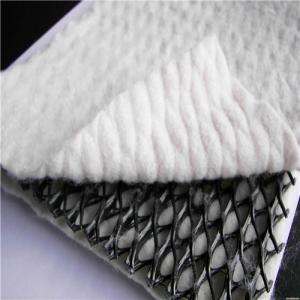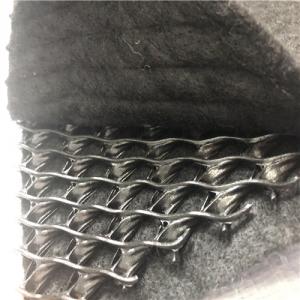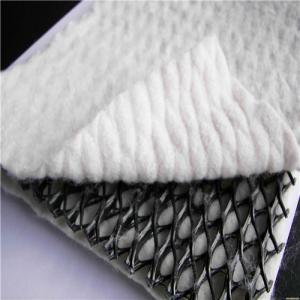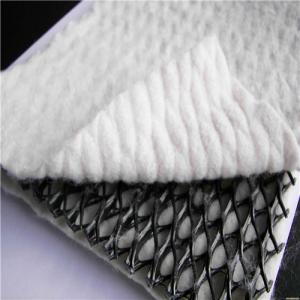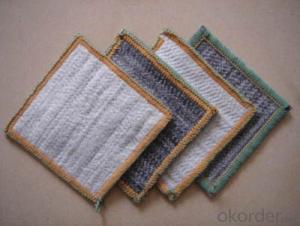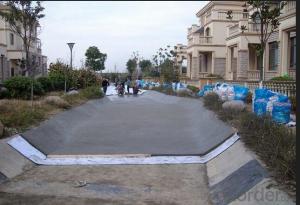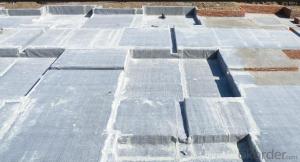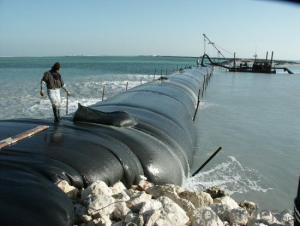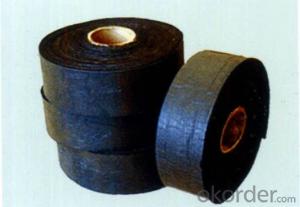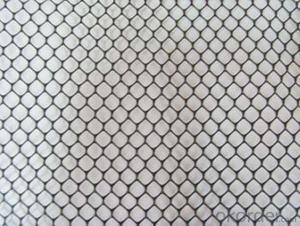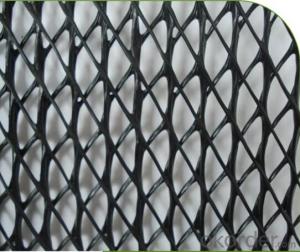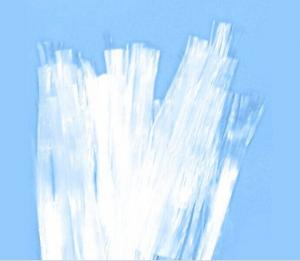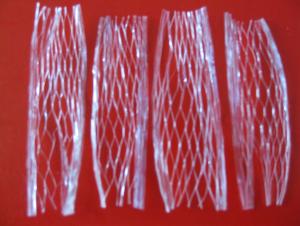HDPE Drainage Geonet used in Construction Earthwork
- Loading Port:
- China main port
- Payment Terms:
- TT or LC
- Min Order Qty:
- 1000 m²
- Supply Capability:
- 1000000 m²/month
OKorder Service Pledge
OKorder Financial Service
You Might Also Like
Composite Geonet Description:
Composite geonet is a new type drainage material. It has three layers: three-dimensional geonet and nonwoven geotextile on both sides.
The material of geonet is HDPE, and the material of geotextile can be needle punched PET/PP nonwoven geotextile, and thermalbonded continuous filament nonwoven geotextile.
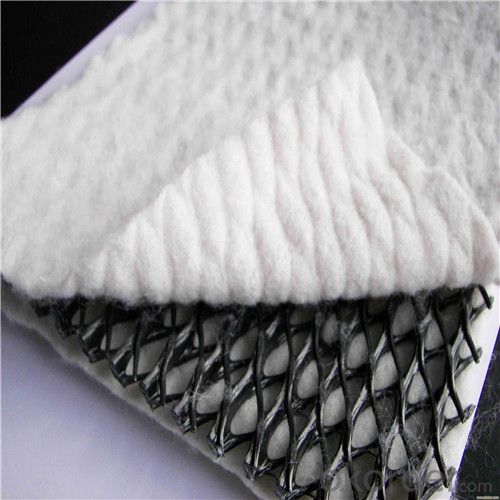
Composite Geonet Specification:
Thickness of geonet: 5mm to 8mm
Weight of geotextile: 200g/m2, as request
Width: 2m-4m
Length: as request
Composite Geonet Application:
Landfill drainage, roadbed and road drainage, railway drainage, tunnel drainage, underground
structure drainage, the retaining back wall
drainage, gardens and sports grounds drainage.
Our Service
1.On a regular basis or as per your request,we entrust national testing agencies to conduct quality inspections
2. Strictly in accordance with the ISO9001-2008 international quality system standard,we monitor and manage the whole process throughout production,quality testing,and measurement to ensure product quality
3. For quality-related construction delay or substandard construction(except for damage or losses due to customer’s responsibility or irresistible natural disasters),we have refunding,replacement,and repair services.We will respond to customers’ feedbacks on quality issues within 24 hours.
4.In order to provide customers with comprehensive technical support,we will provide technical and other related information upon request in a timely manner.
5.In required,we will appoint specialized technicians to the construction site to give technical trainings to construction people,and offer technical guidance throughout the whole construction process.
6.For damage due to shipment and delivery,after we receive the complaint,we will check the issure through provided pictures and videos.If our responsibility is confirmed,we wil offer free replacement.
7.When the construction is completed,as your request,our technical staff may participate in the final acceptance.
FAQ:
Q: What kind of payments does jenor support?
A: T/T, L/C, Cash are accepted.
Q: Do you charge for the samples?
A: Accordeing to our company policy, the samples are free, we only charge the freight fee. And we will return the freight fee during the next order.
Q: Can you produce according to customers' design?
A: Sure, we are professional manufacturer, OEM and ODM are both welcome.
- Q:What are the advantages of using geotextile tubes for canal restoration?
- There are several advantages of using geotextile tubes for canal restoration. Firstly, geotextile tubes provide effective erosion control, preventing further degradation of the canal banks. Secondly, these tubes are made of permeable fabric, allowing water to pass through while retaining sediment, which helps in the natural process of sediment deposition and formation of stable canal beds. Additionally, geotextile tubes are easy to install and can be customized to fit different canal sizes and shapes, making them a versatile solution for restoration projects. Lastly, these tubes are durable, resistant to UV degradation and chemicals, ensuring long-term stability and effectiveness in restoring and maintaining canal infrastructure.
- Q:What are the benefits of using geotextile mats in roadway reinforcement systems?
- There are several benefits of using geotextile mats in roadway reinforcement systems. Firstly, these mats improve the stability and load-bearing capacity of the road, making it more durable and resistant to wear and tear. Secondly, geotextile mats help to distribute the load from traffic evenly, reducing the stress on the road structure and preventing the formation of potholes and cracks. Additionally, these mats act as a barrier to prevent the intermixing of different layers of the road, ensuring the integrity of the pavement and minimizing the risk of structural failures. Moreover, geotextile mats can effectively control soil erosion and stabilize the underlying soil, reducing the need for frequent maintenance and repair. Ultimately, the use of geotextile mats in roadway reinforcement systems leads to cost savings, extended lifespan of the road, and improved overall performance.
- Q:Can earthwork products be used for creating walking paths and trails?
- Yes, earthwork products can be used for creating walking paths and trails. Earthwork products such as gravel, crushed stone, and soil can be used as surfacing materials for walking paths and trails, providing a stable and durable surface for pedestrians. These materials can help control erosion, improve drainage, and enhance the aesthetics of the path or trail. Additionally, earthwork products can be used to shape the terrain and create slopes or embankments along the path or trail to ensure proper grading and safety.
- Q:What are the advantages of using geotextile tubes for breakwater construction?
- There are several advantages of using geotextile tubes for breakwater construction. Firstly, geotextile tubes are cost-effective compared to traditional breakwater materials such as concrete or rocks, making them an affordable option for construction projects. Additionally, these tubes are lightweight and easy to transport and install, reducing both time and labor required for construction. Moreover, geotextile tubes are flexible and can be easily adjusted or repositioned if needed, providing flexibility in design and adaptability to changing coastal conditions. Another advantage is that these tubes can be filled with locally available materials such as sand, which reduces the environmental impact and eliminates the need for transporting heavy materials from a distance. Lastly, geotextile tubes have high durability and are resistant to erosion and wave action, ensuring long-term stability and protection for coastal areas.
- Q:What are the advantages of using geonets in landfill capping?
- Geonets have several advantages when used in landfill capping. Firstly, they provide excellent drainage capabilities, allowing for the efficient removal of leachate from the capped landfill. This helps in preventing the accumulation of harmful liquids, reducing the risk of contamination to the surrounding environment. Secondly, geonets offer high tensile strength, ensuring the integrity and stability of the landfill cap. They can withstand the weight and pressure exerted by waste materials, preventing the cap from collapsing or deforming over time. Additionally, geonets are lightweight and easy to install, making the landfill capping process more efficient and cost-effective. They can be easily rolled out and secured in place, saving time and labor compared to traditional methods. Furthermore, geonets are resistant to chemical degradation, ensuring their longevity and effectiveness in landfill capping. They can withstand exposure to various chemicals found in waste materials, ensuring the long-term performance of the landfill cap. Overall, the use of geonets in landfill capping offers advantages such as improved drainage, increased stability, ease of installation, and long-term durability, making them a preferred choice for landfill closure and environmental protection.
- Q:What are the benefits of using geogrids in mechanically stabilized earth walls?
- There are several benefits of using geogrids in mechanically stabilized earth walls. Firstly, geogrids provide increased stability and strength to the soil, allowing for the construction of taller and steeper walls. Secondly, geogrids distribute and reduce the lateral pressure exerted by the soil, minimizing the risk of wall failure. Additionally, geogrids improve the overall durability of the wall by preventing soil erosion and reducing the effects of settlement and lateral movement. Overall, the use of geogrids in mechanically stabilized earth walls enhances their performance and longevity.
- Q:What are the benefits of using geotextile tubes for dewatering?
- Geotextile tubes offer several benefits for dewatering projects. Firstly, they provide a cost-effective solution compared to traditional methods like mechanical dewatering. They can be easily transported and deployed, reducing labor and equipment costs. Secondly, geotextile tubes are efficient in separating solids from liquids, allowing for faster dewatering and reduced drying time. They also have a high capacity for retaining solids, minimizing the need for additional disposal sites. Lastly, geotextile tubes are environmentally friendly, as they help in sediment control and prevent contaminants from entering nearby water bodies.
- Q:How can geocells be used in green roof systems?
- Geocells can be used in green roof systems by providing structural support and stabilization to the growing medium and vegetation. The cells can be filled with soil or other lightweight materials and arranged on the roof surface to create a network of compartments. This helps to distribute the weight evenly and prevent erosion or displacement of the growing medium. Additionally, geocells can aid in stormwater management by retaining water within the cells, promoting plant growth and reducing runoff. Overall, geocells enhance the durability, sustainability, and functionality of green roof systems.
- Q:What is the function of geosynthetic drainage materials in road shoulder construction?
- Geosynthetic drainage materials in road shoulder construction serve the function of enhancing drainage efficiency by providing a pathway for water to flow away from the road surface. They help prevent the accumulation of water in the road shoulder, which can lead to softening of the soil and potential damage to the road structure.
- Q:What are the advantages of using geosynthetic materials in road shoulder construction?
- There are several advantages of using geosynthetic materials in road shoulder construction. Firstly, geosynthetics provide excellent soil stabilization, preventing erosion and maintaining the integrity of the road structure. Secondly, they can improve drainage by allowing water to pass through while preventing soil particles from clogging the system, thus reducing the risk of water-related damage. Thirdly, geosynthetics are durable and resistant to degradation, ensuring long-lasting performance and reducing the need for frequent maintenance. Lastly, these materials are lightweight and easy to install, resulting in cost and time savings during construction. Overall, geosynthetics offer numerous benefits for road shoulder construction, enhancing the safety, durability, and efficiency of the road network.
1. Manufacturer Overview |
|
|---|---|
| Location | |
| Year Established | |
| Annual Output Value | |
| Main Markets | |
| Company Certifications | |
2. Manufacturer Certificates |
|
|---|---|
| a) Certification Name | |
| Range | |
| Reference | |
| Validity Period | |
3. Manufacturer Capability |
|
|---|---|
| a)Trade Capacity | |
| Nearest Port | |
| Export Percentage | |
| No.of Employees in Trade Department | |
| Language Spoken: | |
| b)Factory Information | |
| Factory Size: | |
| No. of Production Lines | |
| Contract Manufacturing | |
| Product Price Range | |
Send your message to us
HDPE Drainage Geonet used in Construction Earthwork
- Loading Port:
- China main port
- Payment Terms:
- TT or LC
- Min Order Qty:
- 1000 m²
- Supply Capability:
- 1000000 m²/month
OKorder Service Pledge
OKorder Financial Service
Similar products
New products
Hot products
Hot Searches
Related keywords
